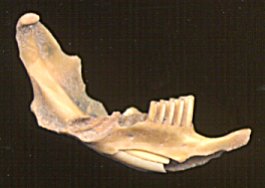

Bags packed and ready to travel! This might seem a good motto for Sagebrush Voles in the Southwest at the end of the Ice Ages as local conditions warmed up and dried out. Not quite an accurate picture, through.
Sagebrush Voles are mice generally associated with Big Sagebrush—a dominant shrub in much of the Great Basin and northern Great Plains. During the latter portions of the late Pleistocene Epoch, these were one of the most common rodents along the Pecos River drainage and also occurred west and south to the Mexican Border. But today, their nearest occurrence is in south-central Utah.
Did they just pick up and leave? Not likely. As with most small,
short-lived animals, geographic distributions changed by attrition and slow spread. As
the environment became unfriendly along the southern fringes of their range,
reproduction couldn't keep up with losses, and vole populations became locally
extinct. Farther north, as once-unfavorable habitats improved, the population edge
spread slowly into now-inhabitable territory. Hundreds of miles of movement, but
imperceptible to any one mouse generation.

Contributor: Arthur H. Harris, Laboratory for Environmental Biology, Centennial Museum, University of Texas at El Paso.
Desert Diary is a joint production of the Centennial Museum and KTEP National Public Radio at the University of Texas at El Paso.

Fossil jaw of a Sagebrush Vole (Lemmiscus curtatus). Scanned specimen from Dry Cave, Eddy Co., New Mexico, about 18,000 years old.
Harris, A. H. 1985. Pleistocene vertebrate paleoecology of the West. University of Texas Press, Austin, 293 pp.